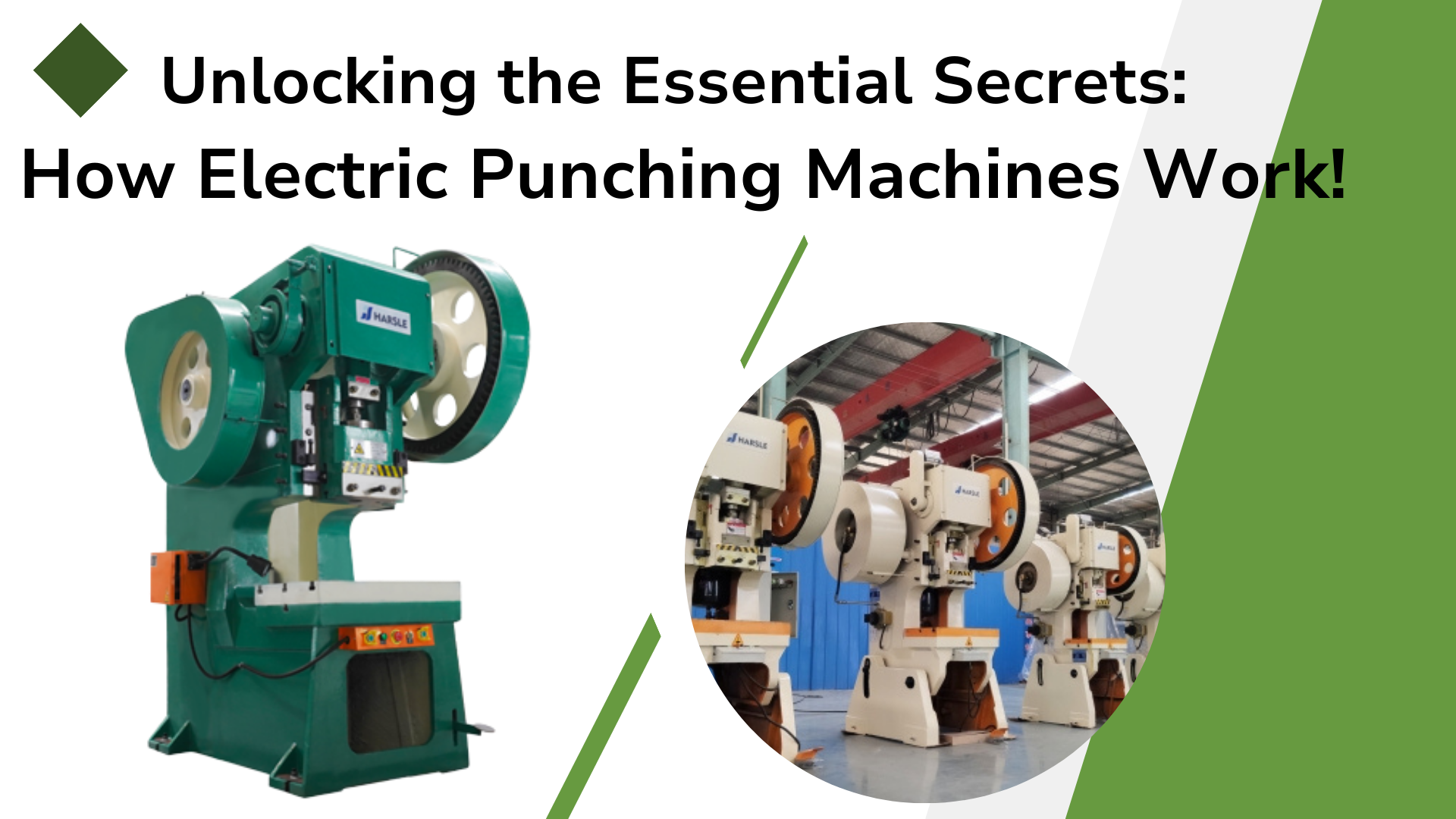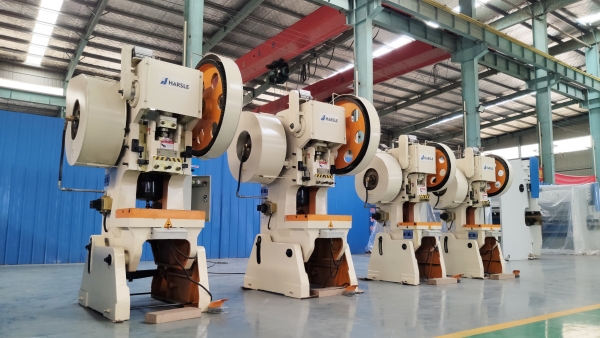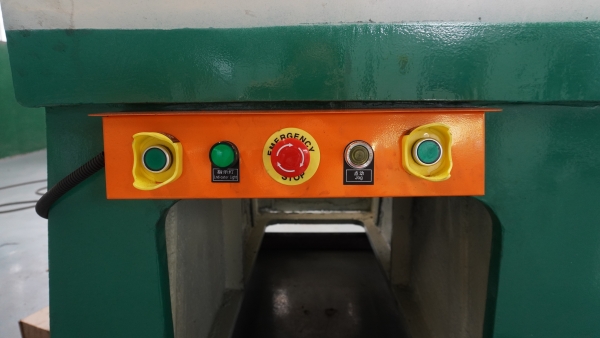Unlocking the Essential Secrets: How Electric Punching Machines Work!

Electric punching machines are an essential tool in many industries, including printing, binding, and manufacturing. These machines play a crucial role in streamlining operations and improving efficiency in the punching process. Understanding how these machines work is vital for maximizing their potential and optimizing workflow. In this article, we will delve into the essential secrets of electric punching machines, shedding light on their mechanisms and functionalities.
Understanding the Components of Electric Punching Machines
Electric punching machines are a critical asset in several industries, aiding in the creation of precise holes in materials for a variety of applications. Understanding the components that constitute these machines is fundamental to comprehending how they function and how to utilize them optimally. In this article, we’ll explore the essential components of an electric punching machine, shedding light on their roles and contributions to the overall functionality of the machine.

- Motor
At the heart of an electric punching machine lies the motor, the primary driving force responsible for powering the machine’s operations. The motor’s power determines the punching force and speed at which the punching action is executed. Depending on the specific machine, the motor may have adjustable settings to regulate the power, allowing for customization based on the material being punched. - Punching Die or Tool
The punching die, also known as the punching tool, is a vital component that directly interacts with the material to create holes. This tool is typically made of high-quality steel and is designed with specific hole patterns corresponding to the desired configuration of holes in the material. The punching die attaches to the motor and moves in a controlled manner to punch holes accurately based on the predetermined pattern. - Material Platform
The material platform serves as the foundation where the material to be punched is placed. Its primary function is to securely hold the material in place during the punching process, preventing any movement or misalignment that could result in inaccuracies. Depending on the design of the machine, the material platform may have features to facilitate easy loading and positioning of the material. - แผงควบคุม
The control panel is the interface through which the operator interacts with the electric punching machines. It allows the operator to input parameters such as hole size, hole spacing, and other relevant settings based on the requirements of the specific punching job. The control panel plays a crucial role in ensuring that the electric punching machines produce holes with the desired specifications. - Guides and Alignment Features
Guides and alignment features are integral components that aid in positioning and aligning the material accurately for hole punching. These components ensure that the material is placed in the correct position relative to the punching die, resulting in precise hole patterns. Proper alignment is essential to achieve consistent and accurate hole punching. - Electrical and Mechanical Systems
Electric punching machines involve intricate electrical and mechanical systems that facilitate the movement and coordination of components. These systems are responsible for translating the input from the operator, processed through the control panel, into the precise movements of the punching die and other related parts during the punching process.

Understanding the role and functionality of each component in electric punching machines is essential for operating and maintaining the machine effectively. It enables operators to optimize the punching process, achieve precise hole configurations, and maximize the efficiency of the machine in various industrial applications. Proper maintenance, calibration, and regular checks on these components ensure the longevity and reliability of the electric punching machines, contributing to sustained productivity and high-quality output.
Powering Up: The Electric Motor
The electric motor is the beating heart of electric เครื่องเจาะ, providing the necessary power and motion to drive the punching mechanism. In the realm of industrial equipment, it is the motor that transforms electrical energy into mechanical force, making it an indispensable component for efficient hole-punching processes. Let’s delve into the intricate world of electric motors and their pivotal role in electric punching machines.
Understanding the Electric Motor
An electric motor is a device that converts electrical energy into mechanical energy through electromagnetic induction. It operates based on the principles of electromagnetism, where the interaction between a magnetic field and an electric current generates rotational or linear motion.

Working Principles of the Electric Motor
- Electromagnetic Induction: When an electric current is applied to the stator windings, a magnetic field is generated.
- Rotor Interaction: The rotor, with its own magnetic field, interacts with the stator’s magnetic field, creating a force that sets the rotor in motion.
- Continuous Rotation: The commutator ensures that the direction of the electric current in the rotor windings changes with each half-rotation, ensuring continuous rotation of the rotor.
The Electric Motor in Electric Punching Machines
In electric punching machines, the electric motor is the driving force that powers the punching die. When the operator initiates the punching process, the motor receives the signal and activates, causing the punching die to descend onto the material. The motor’s power and speed are adjustable, allowing operators to customize the punching force and rate based on the material being punched.
Advantages of Electric Motors in Electric Punching Machines
- Precision: Electric motors enable precise control over the punching mechanism, resulting in accurate hole placements and configurations.
- Efficiency: Electric motors are highly efficient in converting electrical energy into mechanical motion, minimizing energy wastage.
- Adjustability: The motor’s speed and power settings can be tailored to the specific requirements of different materials, optimizing the punching process.
- ระบบอัตโนมัติ: Electric motors facilitate automation, improving productivity and reducing the need for manual intervention in the punching process.
Understanding the electric motor in electric punching machines provides valuable insights into how these machines operate and achieve their intended functionality. It highlights the critical role of the motor in powering the punching action, ultimately contributing to the overall efficiency and precision of hole punching in various industrial applications.
The Punching Mechanism in Action
The punching mechanism in electric punching machines is a fascinating interplay of precise engineering and seamless coordination, resulting in the creation of accurate and consistent holes in various materials. This mechanism is the core of the machine, dictating the outcome of the punching process and determining the efficiency and quality of the final product.
Components Involved
- Punching Die: At the heart of the punching mechanism lies the punching die or tool. Crafted with precision, the punching die contains a specific hole pattern that corresponds to the desired configuration of holes in the material.
- Motor Power: The electric motor, a powerful force, provides the necessary energy to drive the punching die and initiate the punching action. The motor’s power can be adjusted to suit the requirements of different materials.
- Material Platform: The material platform provides a stable surface on which the material to be punched is securely placed. It plays a crucial role in holding the material in position during the punching process.

The Action Unveiled
- Initiation of the Punching Process: As the operator activates the electric punching machines, the motor comes to life. This sets the entire punching mechanism in motion.
- Motor-Driven Movement: The motor powers the upward and downward movement of the punching die. As the die descends, it aligns precisely with the material, preparing for the punching action.
- Alignment and Precision: The material platform, equipped with guides and alignment features, ensures that the material is accurately positioned under the punching die. Proper alignment guarantees the creation of holes in the desired locations.
- Punching Action: With a burst of power, the punching die swiftly moves downward, making contact with the material. The sharp edges of the die cut through the material, creating holes based on the predetermined pattern.
- Retraction and Material Release: After the punching action, the punching die retracts to its initial position. The punched material is then released from the machine, ready for further processing.
Achieving Efficiency and Precision
- Die Design: A well-designed punching die is crucial for achieving the desired hole patterns. Customized dies can be created to suit specific requirements, ensuring precise hole alignment and spacing.
2. Material Consideration: Adjusting the machine’s parameters based on the material being punched, including thickness and type, ensures optimal performance and prevents damage to the material.
3. Regular Maintenance: Routine maintenance of the punching mechanism, including cleaning, lubrication, and inspection, is essential for its smooth operation and longevity.
The punching mechanism in electric punching machines showcases the beauty of engineering and the art of hole creation. Understanding this mechanism’s intricacies is vital for harnessing its potential, optimizing workflow, and achieving exceptional results in a wide array of industrial applications.
Controlling the Punching Process
Controlling the punching process in electric punching machines is akin to conducting an orchestra, where every movement and action must be meticulously directed to achieve a harmonious and precise outcome. The art of controlling the punching process lies in seamlessly orchestrating various components and parameters to deliver accurate and consistent hole-punching results.
The Dance of Precision
- Parameter Input: The operator inputs the desired parameters into the control panel, customizing the punching process according to the specifics of the project. This includes hole diameter, distance between holes, and any unique configurations required.
- Motor Activation: Initiating the punching process triggers the electric motor. The motor powers the punching die, propelling it downward toward the material with precision, guided by the parameters set.
- Real-Time Adjustments: During the punching process, the operator can make real-time adjustments to the motor settings if necessary. This adaptability ensures that the machine can respond to changes in material thickness or other factors affecting the punching operation.
- Quality Control: Monitoring the punching process and inspecting the punched material for accuracy and quality is a crucial step. Any deviation from the desired hole pattern or size can be quickly identified, allowing for immediate adjustments if needed.

Achieving Perfection
- Operator Skill and Training: Well-trained operators with a deep understanding of the machine and its controls are essential for precise control of the punching process. Skillful operators can optimize the parameters effectively, ensuring the best results.
- Regular Calibration: Regularly calibrating the machine to maintain its accuracy and alignment is vital. A well-calibrated machine adheres to the specified parameters consistently.
- Continuous Improvement: Analyzing the punching process and gathering data allows for continuous improvement. Understanding patterns and trends can lead to refinements in the control parameters for enhanced efficiency and quality.
In conclusion, controlling the punching process in electric punching machines is a delicate blend of art and science. It requires a keen eye for detail, an understanding of the machine’s capabilities, and the ability to adapt and optimize settings to achieve the desired hole configurations. With meticulous control, every punch becomes a testament to precision and expertise, resulting in a finished product of the highest quality.
The Feed System: Ensuring Smooth Operations
The feed system in electric punching machines is the unsung hero that facilitates seamless operations, ensuring a steady and efficient workflow. Comparable to the veins and arteries in the human body, the feed system channels materials through the machine, positioning them accurately for the punching process. Let’s explore the vital role of the feed system in an electric punching machine and how it guarantees a smooth and precise punching operation.
Anatomy of the Feed System
- Material Feeder: The material feeder is the entry point of the feed system. It guides the material into the machine and positions it for the subsequent steps. It ensures a consistent flow of materials, preventing jams and disruptions in the process.
- Guides and Rollers: Guides and rollers are strategically placed along the feed path to maintain proper alignment and smooth movement of the material. They prevent the material from deviating from the intended path, guaranteeing accurate positioning for hole punching.
- Material Conveyor: The material conveyor, often equipped with belts or rollers, carries the material through the machine at a controlled speed. This component plays a vital role in regulating the material’s movement, allowing for precise hole placement.
- Alignment Mechanism: The alignment mechanism within the feed system ensures that the material is correctly positioned relative to the punching die. It adjusts the material’s placement, aligning it for the punching process, and contributes to the accuracy of the hole patterns.
- Sensors and Detectors: Sensors and detectors are integrated into the feed system to monitor the material’s movement and detect any irregularities or jams. They act as a safety net, halting the machine if issues are detected, and preventing potential damage.

The Flow of Efficiency
- Material Entry and Guiding: The material is introduced into the machine through the material feeder, where it is guided onto the conveyor system.
- Guided Movement: As the material advances through the feed system, guides and rollers ensure it maintains a precise and steady path.
- Alignment and Preparation: The alignment mechanism adjusts the material’s position, aligning it accurately for the upcoming punching action.
- Seamless Punching: Once the material is appropriately positioned, the punching die descends, creating holes in the material as intended.
- Continued Movement: After punching, the feed system continues to guide the material, ensuring a consistent flow and preparing it for subsequent processes or further usage.
Key Benefits and Considerations
- Efficiency: A well-designed and maintained feed system optimizes material flow, maximizing the efficiency of the punching process.
- ความแม่นยำ: The feed system’s precision in positioning and alignment contributes to the accuracy of hole placements in the material.
- Prevention of Jams: Properly functioning guides and sensors prevent material jams, minimizing disruptions and potential damage to the machine.
- Customization and Adaptability: Modern electric punching machines offer adjustable feed system settings, allowing operators to customize the feeding process based on the material and punching requirements.
In conclusion, the feed system is a fundamental component that ensures the smooth and efficient operation of electric punching machines. It not only guides the material but also sets the stage for precise hole punching, ultimately influencing the quality and productivity of the entire punching process. Understanding and optimizing the feed system is essential for harnessing the full potential of electric punching machines in various industrial applications.
